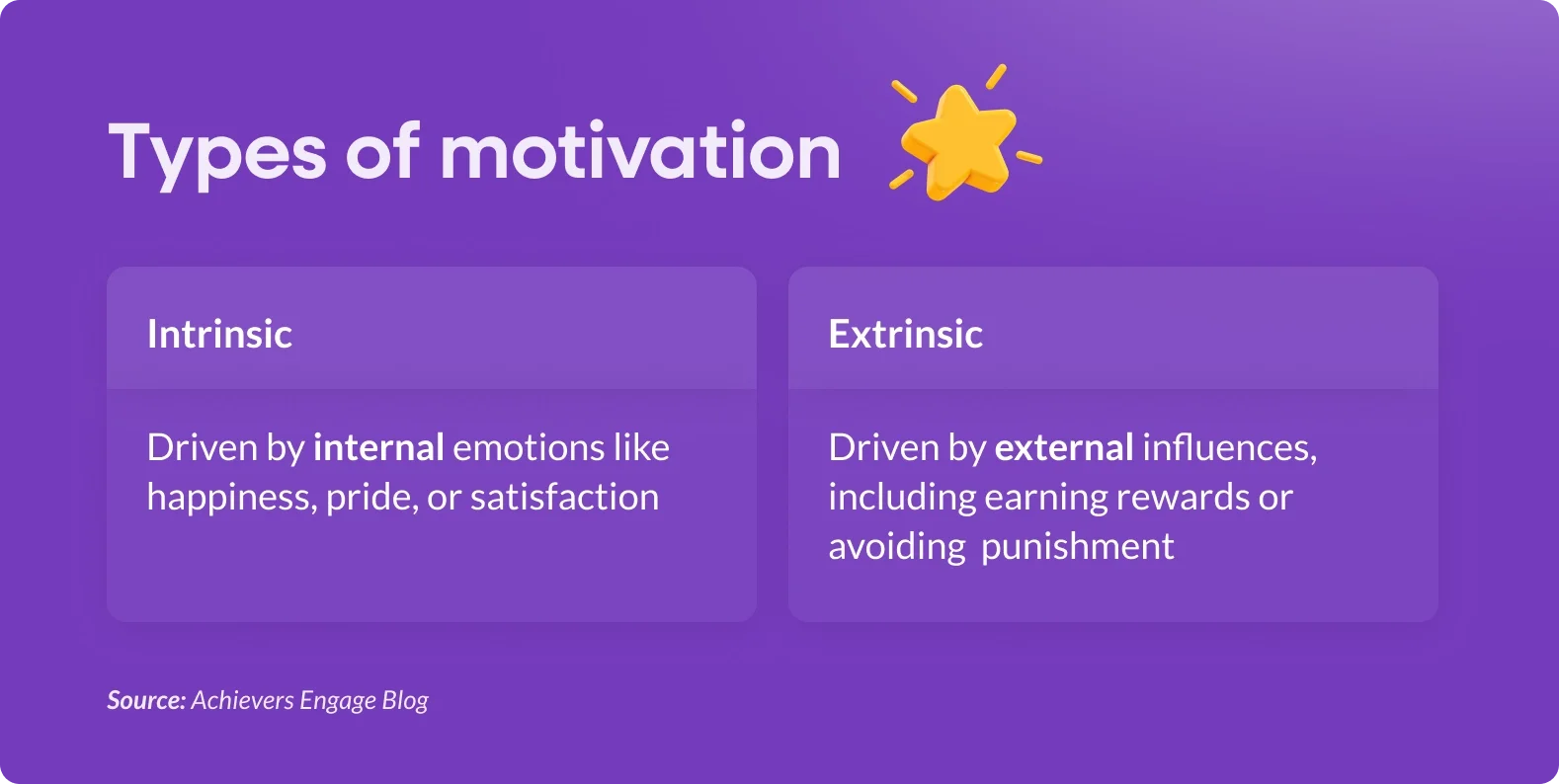Table of contents
Employee motivation can have a major impact on business success, but keeping team members motivated isn’t always easy. It’s not hard to see why — every employee responds to different motivators, and investing in the wrong ones can drain your company’s budget without producing any tangible results.
Employee preferences also change over time. That means what engages your workforce now might not be the same a year or more down the road. It’s more important than ever for employers to adapt, especially after research from Gallup found employee engagement fell to 31% in the United States in 2024.
So how can your organization stay on top of employee motivation and engage team members in a way that empowers them to be your organization’s biggest advocates? It’s easier than you might think.
Let Achievers help you understand what drives motivation, the types of incentives that matter most to today’s workers, and how to stay connected to employee sentiment every step of the way.
What is employee motivation?
Employee motivation is the level of commitment, drive, and creativity that your team brings with them to work every day. It has a major impact on almost every part of your company, influencing everything from overall team performance and morale to productivity and the quality of work.
Motivated employees do everything they can to get the job done, serving as examples for the rest of the company. Without motivated employees, organizations run the risk of losing out on their top talent and missing key business goals.
The good news is employee motivation is tangible and can be nurtured. Beyond the obvious incentives, like raises and promotions, organizations can look to tailor rewards as a way to celebrate their employees and reward the behaviors that drive business success. These incentives can range from work flexibility and professional development to meaningful recognition.

Types of motivation
There are two types of motivation: intrinsic and extrinsic. These terms describe what pushes employees to put in the effort and make things happen.
Intrinsic motivation comes from internal emotions like happiness, pride, or satisfaction, driving engagement and creativity. Extrinsic motivation is fueled by external rewards or consequences, helping achieve short-term goals and maintain accountability. Understanding the difference between them is key to improving employee motivation and creating a workplace where everyone feels energized and inspired.
Measuring employee motivation
Measuring employee motivation is key to understanding where your organization stands and how to improve. By gathering honest feedback through various tools, you can identify areas for growth and take meaningful action.
- Establish a baseline: Before improving employee motivation, measure where things currently stand.
- Gather honest feedback: Clear insights come from open and honest employee input.
- Use surveys and polls: Custom survey questions and anonymous employee feedback tools help employees share thoughts without disrupting their workflow. Employers can see what’s working, what’s not, and where to focus improvement efforts.
- Leverage HR chatbots: HR chatbots help gather anonymous feedback anytime, providing an always-on channel for employees to share needs and ideas.
5 ways to improve employee motivation
While employee feedback is a valuable tool that can help measure employee motivation, it’s not the only solution. Here are five ways companies can improve employee motivation starting today:
1. Focus on employee engagement
Employee engagement and motivation go hand in hand. When employees are engaged, they’re genuinely excited about their work and proud to be part of your organization. To boost engagement, it’s important to understand what truly drives it. That’s where surveys and real-time feedback platforms can help give you a clear picture of how your team feels and where to focus your efforts.
One of the best ways to strengthen engagement is through meaningful recognition. In fact, employees who receive at least monthly meaningful recognition from their managers report 3x more trust in their managers and view them as 2.5x more effective. Combine recognition with initiatives that support employee wellness, and you’ll create a workplace where motivation and engagement thrive.
2. Build an impactful employee recognition program
Employee recognition includes all the ways your team members are thanked and rewarded for their work. It’s a key driver of employee motivation — after all, if employees aren’t both told they’re appreciated and shown it in tangible ways, why should they continue to give their all on a daily basis? That means any effective recognition program should include both social and monetary components.
To start building a culture of recognition at your company, choose an employee recognition software with a platform that’s easy to use, lets all team members say thank you in fun, engaging ways, and includes a points-based rewards system backed by an incredible catalog.
3. Offer great incentives
While the typical employee incentives — like retirement benefits and health insurance — are still top of mind, it takes more than that to motivate many employees today. But don’t worry — offering perks that excite employees doesn’t have to break the bank.
The most impactful incentives can range from professional development opportunities to flexible work arrangements and wellness benefits like gym memberships or mental health support. Tailoring incentives to what your team genuinely cares about and aligning them with company values shows them their needs and interests matter.
4. Create a culture employees love being a part of
Organizational culture is the combination of values, expectations, and practices that guide what your team does each day. If your company culture makes employees feel like they belong, it’s much easier for them to become invested in the success of your business.
For many employees, culture is one of the primary reasons they stay at their current jobs. When companies are transparent, authentic, positive, and connect employee work to a purpose, it creates a deeper sense of belonging — one that encourages teamwork and collaboration toward company goals.
5. Empower employees to succeed
When employees feel empowered, they’re confident that their manager and the organization have their back and will provide the support and resources they need to succeed. Empowering employees starts with getting direct input from them on what they need to thrive and what’s standing in their way.
To offer that type of support, organizations may have to look at retraining managers who tend to micromanage instead of coach, boosting talent development opportunities, or adjusting work-life balance so team members have the time and energy to truly excel.
The impact of employee motivation on business outcomes
Motivated employees aren’t just putting in more effort — they’re delivering stronger business results. When employees feel valued, recognized, and truly connected to their work, engagement, productivity, and commitment skyrocket.
Achievers empowers businesses to unlock this motivation through regular recognition, seamless integrations, and real-time insights. Here’s how we help fuel business success:
Increases employee engagement
- 2x the recognition rates of other providers, driving deeper engagement.
- Built-in software integrations and dedicated customer success strategies ensure motivation thrives daily, boosting employee morale and productivity.
Drives behavior change at scale
- AI-powered insights and personalized recognition help sustain motivation and shape desired behaviors.
- Robust reporting uncovers key behaviors, allowing organizations to scale impactful actions that drive business outcomes.
Reduces turnover and improves retention
- Personalized rewards and 24/7 multi-language support enhance employee connection.
- Seamless HR tech integrations help support a culture of appreciation and retention.
Creates a seamless recognition and reward experience
- A global rewards marketplace with localized fulfillment serving nearly 190 countries.
- Expert-backed strategies help companies operationalize recognition across the entire employee lifecycle, ensuring consistency and impact at every touchpoint.
Drive employee motivation and success with Achievers
When employees feel motivated, they don’t just work harder — they work smarter, more creatively, and more collaboratively.
At Achievers, we believe that motivation is the key to unlocking the full potential of your team. By integrating recognition into daily workflows, offering personalized rewards, and offering real-time insights, you can nurture motivation and create a company culture where employees feel seen, heard, and appreciated.
It’s not just about improving engagement or boosting productivity — it’s about building lasting connections that fuel long-term success. Let Achievers help you harness motivation and make it a driving force for your business.



